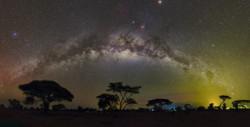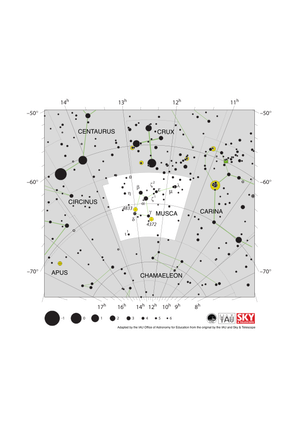Glossary term: 南十字星
Description: 南十字星是南半球星座南十字座的俗称。它有五颗肉眼可见的恒星,形成一个长十字,结构紧凑,易于辨认。南十字座是 88 个官方星座中覆盖天球面积最小的星座。其中最亮的恒星 alpha Crucis 是一个三星系统,而 beta Crucis 则是一颗造父变星。南十字座还包含一个令人惊叹的疏散星团——宝盒星团(NGC 4755)。南十字座可以用来帮助寻找南方和天体的南极,它的图案也出现在澳大利亚、巴西、新西兰、巴布亚新几内亚和萨摩亚的国旗上。
Related Terms:
See this term in other languages
Term and definition status: The original definition of this term in English have been approved by a research astronomer and a teacher The translation of this term and its definition is still awaiting approval
The OAE Multilingual Glossary is a project of the IAU Office of Astronomy for Education (OAE) in collaboration with the IAU Office of Astronomy Outreach (OAO). The terms and definitions were chosen, written and reviewed by a collective effort from the OAE, the OAE Centers and Nodes, the OAE National Astronomy Education Coordinators (NAECs) and other volunteers. You can find a full list of credits here. All glossary terms and their definitions are released under a Creative Commons CC BY-4.0 license and should be credited to "IAU OAE".
If you notice a factual or translation error in this glossary term or definition then please get in touch.
Related Media
半人马座-豺狼座-南十字座全景:半人马座驮着野兽,沿银河驰骋
Credit: Uwe Reichert/IAU OAE
License: CC-BY-4.0 Creative Commons 署名 4.0 国际 (CC BY 4.0) icons
猴面包树大道上空的银河
Credit: Amirreza Kamkar/IAU OAU
License: CC-BY-4.0 Creative Commons 署名 4.0 国际 (CC BY 4.0) icons
安波塞利国家公园上空的银河拱门
Credit: Amirreza Kamkar/IAU OAE
License: CC-BY-4.0 Creative Commons 署名 4.0 国际 (CC BY 4.0) icons
夜空中最亮的星
Credit: Giorgia Hofer/IAU OAE
License: CC-BY-4.0 Creative Commons 署名 4.0 国际 (CC BY 4.0) icons
赤道银河
Credit: Giorgia Hofer/IAU OAE
License: CC-BY-4.0 Creative Commons 署名 4.0 国际 (CC BY 4.0) icons
Related Diagrams
Crux Constellation Map
Credit: Adapted by the IAU Office of Astronomy for Education from the original by IAU/Sky & Telescope.
License: CC-BY-4.0 Creative Commons 署名 4.0 国际 (CC BY 4.0) icons
Musca Constellation Map
Credit: Adapted by the IAU Office of Astronomy for Education from the original by the IAU and Sky & Telescope
License: CC-BY-4.0 Creative Commons 署名 4.0 国际 (CC BY 4.0) icons















